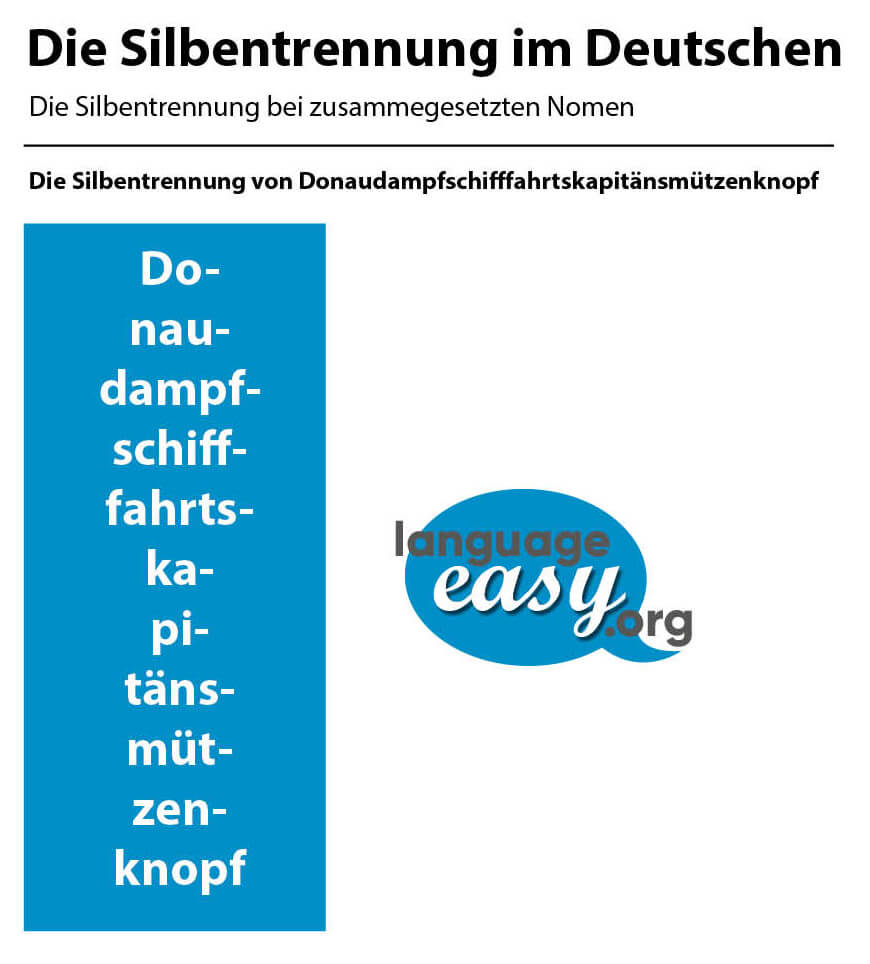German Word Division
Die Silbentrennung im Deutschen
German Word Division – Summary
Zusammenfassung
In German, it is easy to create longer words by adding prefixes and suffixes or simply by unifying words, the so-called compound words.
- “ab-, an-, auf-, aus-, bei-, ein-, los-, mit-, nach-, her-, hin-, um-, vor-, weg-, zu-, zurück, be-, ge-, er-, zer-, ver-, emp-, ent-, miss-, -chen, -heit, -keit, -land, -ling, -nis, -schaft, -tum” …
Sometimes, it gets difficult to recognize a compound word, so you have to identify the spots where you separate the word by certain syllables, so called “Sprechsilben”. Normally, you can identify these syllables by reading the words slowly and loudly. But as this method is rather complicated for non-German speakers, you should stick to some other rules.
- The consonant-connections “ch, ck, hr, sch, ph, sh, th” never get separated.
- The diphthongs “ai, au, äu, ei, eu, oi” are never separated, either.
- Single vowels at the beginning or at the end of a word can not be separated.
And, in case you want to read out these words loudly, just remember the following rules:
- In case there is a word with “ss” or “ß” between two vowels, you separate it between the two “s“.
(for example “ß” gets separated “s – s“). - And the most important rule: Compound words are separated before a single consonant in the word.
Unfortunately, the German language can be pretty ugly sometimes. Well, ugly in the sense of complicated. And there is a part of German grammar that seems to be even more complicated: The compound nouns and their division, so the correct separation of these nouns.
“Donaudampfschifffahrtskapitänsmützenknopf”
Well, this beautiful word consists of 41 letters, and I could make it longer, if I wanted. Luckily, the same rules that allow us to build these long German compound nouns, also show us how to apply German word division in a correct way. In this case, it would be “Do-nau-dampf-schiff-fahrts-ka-pi-täns-müt-zen-knopf”. So, in this article I’d like to show you the different rules of German word division with German nouns and also verbs.
Now, we will not lose too much time and start summarizing these two topics. By the way, there some parts of German word division that you will simply have to learn. Well, in order to do so, I can recommend this hyphenation tool, which will always show you how to separate German vocabulary in the right way. And now – Los geht’s!
German Compound Nouns
Zusammengesetzte Nomen im Deutschen
Well, the first part of this article will be about German compound nouns. As already mentioned, German word division with these long types of German nouns might seem rather difficult. But once you have understood the principles, you will see that it’s quite easy.
So, the rule is quite easy: The German hyphenation with German compound nouns is realized after the connector.
Well, that means that you simply have to analyze your compound noun, recognize the single nouns it consists of and separate them after the connector. So, there are the following connectors
The Most Common Connectors
- The “e” connector
“Hund” – “müde” – “hundemüde”
“Hund” – “Fleisch” – “Hundefleisch” - The “n” or “en” connector
“Biene” – “fleißig” – “bienenfleißig”
“Löwe” – “Zahn” – “Löwenzahn” - The “ens” connector
“Schmerz” – “Geld” – “Schmerzensgeld” - The “er” connector
“Wund” – “Heiler” – “Wunderheiler” - The “s” or “es” connector
“Weihancht” – “Lied” – “Weihnachtslied”
“Liebling” – “Farbe” – “Lieblingsfarbe” - Without connector
“Fuß” – “Ball” – “Fußball”
“Wasser” – “Lieferant” – “Wasserlieferant”
Please, keep in mind the German word division by syllables. Well, you simply have to combine the word separation with the separation after connectors.
Separable Verbs
Trennbare Verben
Well, another possibility to figure out at which point of a word you can separate are the German separable verbs. So, here you can apply German word division after every prefix.
Of course, this is only a useful trick. Finally, you will have to study your German vocabulary in a way that allows you to recognize the syllables of every word. Well, that’s the only way – but I think I have already mentioned that above.
Please, take a look at our article about German separable verbs mentioned above. Nevertheless, there is a short list of the most important prefixes of separable verbs, where German word division can be applied.
ab-, an-, auf-, aus-, bei-, ein-, los-, mit-, nach-, her-, hin-, vor-, weg-, zu-, zurück-, durch-, hinter-, über-, um-, unter-
Well, of course, German word division can also be applied after the prefix “ge-” and other ones used to form the German participle.
Exercise
Übungen
Finally we have reached the last part of this article where you can proof the German skills you have just learned. In the following you will see some phrases that you should complete with the correct terms. Once you have filled all the gaps, just click on the “correct” button and you can see your errors and the correct results. Good luck and .. auf Wiedersehen!



